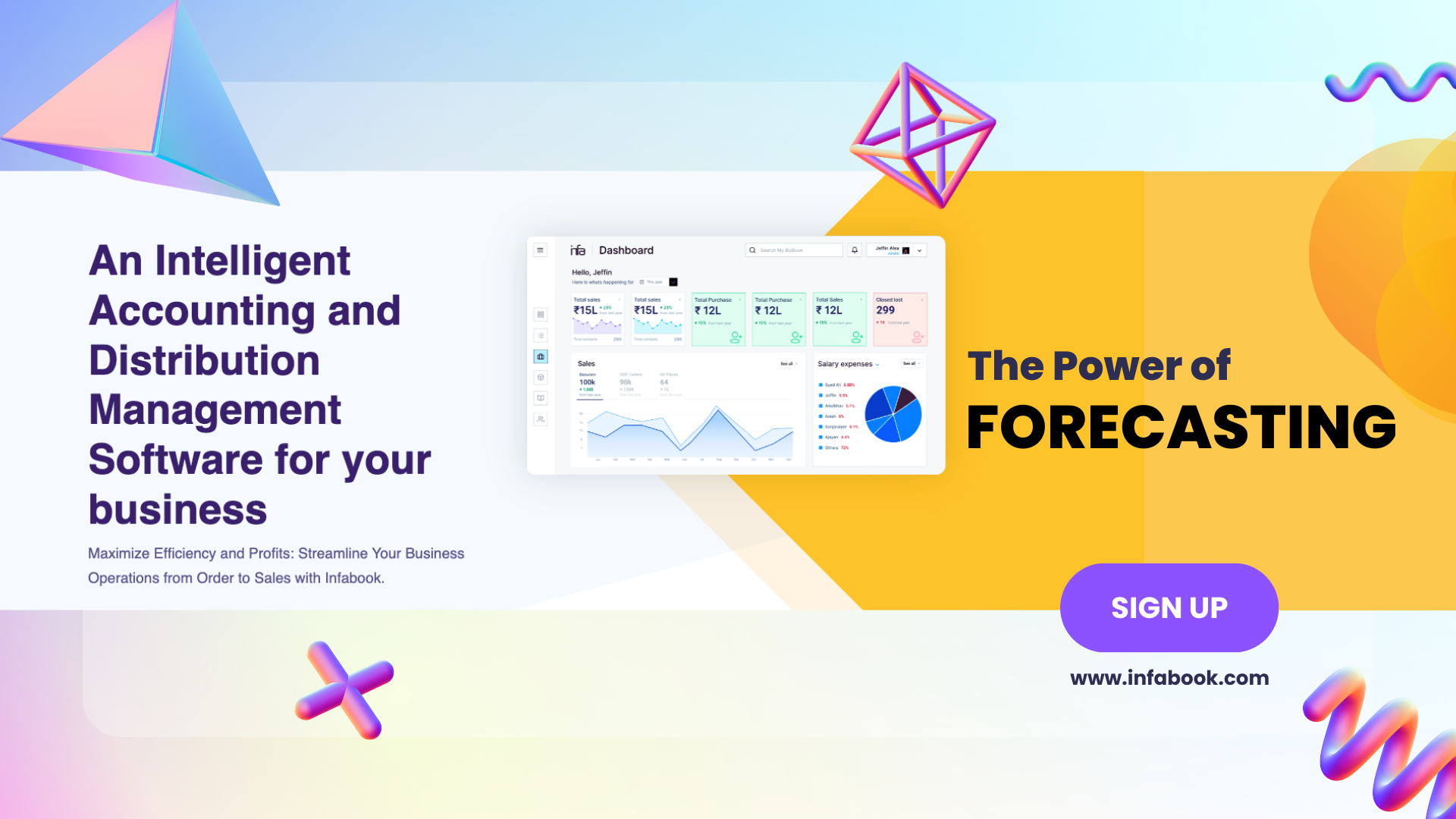
-
By - Mr Jeffin Alex
-
August 30, 2023
-
5 Mins Read
"The best way to predict the future is to create it." - Peter Drucker
The Distribution Industry, like all industries, faces an uncertain future. Changes in customer preferences, technological advancements, global economic shifts, and other unexpected events can disrupt even the most well-laid plans. However, there's a tool that can help businesses navigate these uncertainties and make informed decisions - Forecasting.
What is Forecasting?
At its core, forecasting is a method used to predict future events or conditions based on historical data and trends. It's akin to a compass guiding a ship through uncharted waters, providing insights into what lies ahead so that businesses can adjust their strategies accordingly.
Forecasting is an essential tool for the Distribution Industry. It enables businesses to anticipate customer demand, plan inventory levels, identify market trends, and make informed investment decisions. It's like having a crystal ball that provides glimpses into the future, enabling businesses to plan their operations more accurately and efficiently.
Forecasting isn't 100% accurate, but it doesn't have to be. The goal is to reduce uncertainty and improve decision-making, not to predict the future with perfect precision.
How does Forecasting Benefit the Distribution Industry?
Forecasting offers a plethora of benefits that can revolutionize the decision-making process in the Distribution Industry. Here are a few examples:
- Anticipating Customer Demand: By analyzing past sales data and market trends, businesses can predict future demand for their products. This allows them to adjust their production and inventory levels accordingly, thus reducing the risk of overstocking or understocking.
- Resource Allocation: With accurate forecasts, businesses can allocate their resources more efficiently. This can lead to cost savings, improved operational efficiency, and increased profitability.
- Strategic Planning: Long-term forecasts can aid in strategic planning and goal setting. By identifying potential market trends and growth opportunities, businesses can develop strategies to capitalize on these trends.
- Risk Management: Forecasting can help identify potential risks and challenges. This allows businesses to develop contingency plans and risk mitigation strategies, thus reducing their vulnerability to unexpected events.
The Different Types of Forecasting
There are several different types of forecasting methods, each with its own advantages and disadvantages. The most appropriate method depends on the specific needs and circumstances of the business.
Qualitative Forecasting
Qualitative forecasting methods rely on expert opinions and subjective judgments. Examples include market research surveys, focus groups, and the Delphi method, which involves soliciting opinions from a panel of experts.
Despite their subjective nature, qualitative methods can provide valuable insights, especially in situations where hard data is scarce or unreliable. However, they are typically best suited for short-term predictions and may be less reliable for long-term forecasting.
Quantitative Forecasting
Quantitative forecasting methods, on the other hand, rely on mathematical models and statistical analysis. They use historical data to identify trends and patterns, which are then extrapolated to predict future events. Examples of quantitative methods include time series analysis, regression models, and econometric modeling.
Quantitative methods are typically more objective and precise than qualitative methods. However, they rely heavily on the quality and reliability of the data, and may not account for unforeseen events or changes in underlying factors.
Artificial Intelligence
Artificial intelligence (AI) is becoming increasingly popular in the field of forecasting. AI techniques such as machine learning and neural networks can analyze large datasets, identify complex patterns, and make predictions with high accuracy.
However, AI forecasting models require a large amount of data and advanced technical expertise to develop and maintain. Moreover, they can sometimes be "black boxes," making it difficult to understand how they arrived at a particular prediction.
Key Forecasting Techniques for the Distribution Industry
The Distribution Industry often relies on a combination of forecasting techniques to predict future demand, inventory needs, and market trends. Here are some of the most commonly used techniques:
Time Series Analysis
Time series analysis is a statistical technique used to analyze data collected over time. It identifies trends, patterns, and seasonality in the data, which can be extrapolated to make future predictions. Time series analysis is commonly used in the Distribution Industry to forecast demand, sales, and inventory needs.
Regression Models
Regression models are a type of statistical model used to estimate the relationships between variables. In the Distribution Industry, regression models can be used to predict demand based on factors such as price, promotional activities, and economic indicators.
Artificial Intelligence
Artificial Intelligence and Machine Learning are increasingly being used in the Distribution Industry for forecasting. These techniques can analyze large datasets, identify complex patterns, and make highly accurate predictions. For example, AI can be used to forecast demand at a granular level, taking into account factors such as weather, holidays, and local events.
The Forecasting Process
Forecasting is not a one-off exercise but an ongoing process. Here's a simplified overview of the forecasting process:
- Define the Problem: The first step in the forecasting process is to clearly define the problem or question to be answered. This could be something like, "What will our sales be next quarter?" or "How much inventory should we stock for the holiday season?"
- Collect and Analyze Data: The next step is to collect and analyze relevant data. This could include historical sales data, market research, economic indicators, and other relevant information.
- Choose a Forecasting Method: Based on the data and the nature of the problem, choose the most appropriate forecasting method.
- Make the Forecast: Use the chosen method to make the forecast. This could involve building a statistical model, conducting a survey, or using an AI algorithm.
- Review and Update the Forecast: Regularly review and update the forecast based on new data and changes in circumstances. The forecasting process should be iterative, with constant learning and improvement.
The Challenges of Forecasting in the Distribution Industry
While forecasting can provide valuable insights, it's not without its challenges. Here are a few potential pitfalls to be aware of:
- Data Quality and Availability: Accurate forecasting relies on high-quality, reliable data. However, data can sometimes be incomplete, outdated, or inaccurate. Moreover, certain types of data (such as customer preferences or market trends) may be difficult to quantify.
- Complexity of the Distribution Industry: The Distribution Industry is affected by a myriad of factors, from economic conditions to technological advancements to changes in customer behavior. This complexity can make forecasting challenging.
- Unpredictability: Despite our best efforts, the future is inherently uncertain. Unexpected events (like a global pandemic or a sudden market crash) can disrupt even the most accurate forecasts.
The Balance Between Data and Intuition
While data-driven forecasting is a powerful tool, it's important to maintain a balance between data analytics and human intuition. Over-reliance on data can lead to "analysis paralysis," where decision-making becomes bogged down by excessive data analysis. On the other hand, ignoring data and relying solely on intuition can lead to poor decisions based on biases or assumptions.
In the Distribution Industry, the most successful businesses often combine data-driven forecasting with expert judgment and industry knowledge. They use data to inform their decisions, but also take into account qualitative factors and human insights.
Conclusion
Effective distribution management software like Infabook can be a valuable asset for businesses in the Distribution Industry. It can help them anticipate customer demand, plan inventory levels, identify market trends, and make informed investment decisions. By using a tool like Infabook, businesses can streamline their operations, improve their overall efficiency, and stay ahead of the competition.
In combination with effective forecasting techniques, software like Infabook can revolutionize decision-making in the Distribution Industry. By leveraging both data analytics and human intuition, businesses can make informed decisions and stay ahead of the curve.
Recent Blog
-
 September 07, 2023
September 07, 2023 -
 July 27, 2023
July 27, 2023Streamline Your Inventory Management with Infabook
-

-

-



